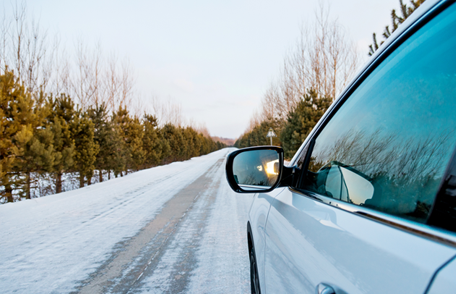Tips for Driving Safely This Holiday Season

In the United States, motor vehicle crashes are a leading cause of death for people aged 1‒54, and more than 37,000 people were killed in crashes in 2017.1,2
However, motor vehicle crash deaths can be prevented. Buckle up, drive sober, and stay safe on the roads this holiday season.
Learn safety tips for:
- All drivers
- Child passengers
- Teen drivers
- Older adult drivers
Safety Tips for All Drivers
- Do not drive when you are impaired by alcohol and/or drugs, and do not allow your family members or friends to drive while impaired. In 2017, drunk driving contributed to more than 10,800 crash deaths.1 If you drink alcohol and/or use drugs, you should designate a non-drinking driver, call a taxi, or use a ride share service.
- Avoid distractions while driving, such as using your cell phone to text, email, or access social media. Sending or reading a text takes your eyes off the road for at least five seconds. At 55 miles per hour, that is like driving the length of an entire football field with your eyes closed. You cannot drive safely unless the task of driving has your full attention.
- Check the weather conditions before you head out on the road. Make sure to drive at a speed that is safe for road and weather conditions.

Learn more about child passenger safety and its four stages (rear-facing car seats, forward-facing car seats, booster seats, and seat belts).
Find out how Parents Are the Key in helping keep teen drivers safe.
Discover steps older adults can take to stay safe on the roads.
Child Passenger Safety Tips
Motor vehicle crash injuries are a leading cause of death among children2, but you can make a difference by making sure kids are properly buckled on every ride. Protect yourself and your children and keep this holiday season injury free.
- Buckle children in age- and size-appropriate car seats, booster seats, and seat belts, which reduce the risk for injury in a car crash by up to 80 percent.
- Children are safest when car seats and booster seats are used correctly. Buckle children the right way in the right seat and learn how to avoid the most common mistakes.
- Remember that bulky/puffy coats should not be used underneath a car seat harness. Bulky clothing makes it difficult to tighten a car seat harness properly. A loose harness is very dangerous and can lead to serious injuries and even ejection from the car seat.
- Instead, properly buckle the harness first. Then, place a coat or blanket over the buckled child. This will not interfere with the harness and will still keep the child warm. For more information, you can visit the Winter Car Seat Safety Tips page on American Academy of Pediatrics’ (AAP) website for parents.
- Remember that children aged 12 and under should be properly buckled in the back seat of the vehicle.
- Set a good example by always using a seat belt yourself.
Tips for Teen Driver Safety
If you have a teen driver in your family, take advantage of safe teen driving resources.
- Do you know the leading causes of teen crashes and injuries, including driver inexperience, driving with teen passengers, nighttime driving, and not using seat belts?
- Discuss the rules of the road with your teen. Consider creating a Parent-Teen Driving Agreement that puts the rules in writing so that limits and expectations are clear.
- Know your state’s laws. All states have graduated driver licensing (GDL) systems, which help ensure teens can build driving skills under lower-risk conditions.
- Get in some supervised driving time with your teen over the holidays while he/she is not in school. Practicing driving under your supervision in different kinds of weather is helpful for providing your teen with valuable driving experience in varied conditions (when the weather is not too severe or dangerous).
- Require your teen to buckle up in every seating position and on every trip. Set a good example by doing the same. Using seat belts can reduce the risk of death or serious injury in a motor vehicle crash by about half.3
Older Adult Driver Safety Tips
Driving helps older adults stay mobile and independent. However, the risk of being injured or killed in a motor vehicle crash increases as people age. Thankfully, if you are an older adult driver, there are steps you can take to stay safe on the roads.
- Ask your doctor or pharmacist to review medicines—both prescription and over-the-counter—to reduce side effects and interactions that could affect your ability to drive.
- Have your eyes checked by an eye doctor at least once a year. Wear glasses and corrective lenses as directed.
- Consider alternatives to driving, such as riding with a friend, using public transit, or using a ride share service to get around.
- Download and use CDC’s MyMobility Plan for more tips and resources about how to make a plan to stay mobile and independent as you age. Take action now to prevent or reduce the effects of possible mobility changes.
References
- National Highway Traffic Safety Administration (NHTSA), National Center for Statistics and Analysis (NCSA). Traffic Safety Facts 2017: A Compilation of Motor Vehicle Crash Data. [cited 2019 November 13]. Available from URL: https://crashstats.nhtsa.dot.gov/Api/Public/ViewPublication/812806.
- Centers for Disease Control and Prevention (CDC), National Center for Injury Prevention and Control (NCIPC). Web-based Injury Statistics Query and Reporting System (WISQARS). [cited 2019 November 13]. Available from URL: http://www.cdc.gov/injury/wisqars.
- Kahane CJ. National Highway Traffic Safety Administration (NHTSA). Lives saved by vehicle safety technologies and associated Federal Motor Vehicle Safety Standards, 1960 to 2012–Passenger cars and LTVs–With reviews of 26 FMVSS and the effectiveness of their associated safety technologies in reducing fatalities, injuries, and crashes (Report No. DOT HS 812 069). Released January 2015. Available from URL: https://crashstats.nhtsa.dot.gov/Api/Public/ViewPublication/812069.






















.png)











No hay comentarios:
Publicar un comentario